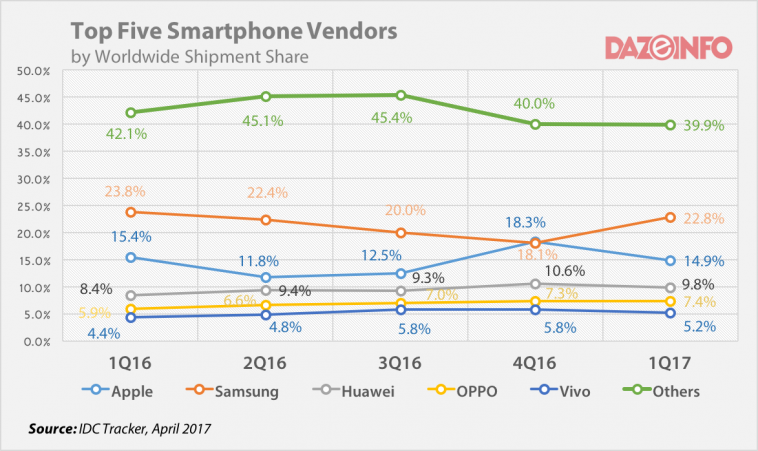The smartphone market in Africa has faced a serious decline between March and September of 2017. However, the market has bounced back to life and recorded a quarter-on-quarter (QoQ) increase of 4.4% in the third quarter of 2017 this is according to information released by International Data Corporation (IDC) a few days ago.
Shipping of the smartphones for the quarter in Africa went to 21.7 million units boosted by the current economic growth in a number of the African main markets. Year on year (YoY) shipping had a negative deviation of 5.5% although that still shows an improvement on the YoY development seen in the last two quarters according to the global technology research and consulting firm’s Quarterly Mobile Phone Tracker.
In the feature phone market, shipping amounted to 33.7 million units, a negative deviation of 3.6% QoQ after increasing for the past three quarters. However, YoY, the feature phone market recorded a positive deviation of 11.5%. Feature phones still make a significant 60.8% share of the total mobile phone market as they extensively address the needs of African consumers that have limited purchasing ability and require a reliable, long-lasting mode of communication, especially those in rural areas.
The total Africa mobile phone market realized shipments of 55.4 million units in the third quarter of 2017, this represents a small decrease margin of -0.7% but an increase of 4.2% YoY. There was a contrast between the two biggest African markets with South Africa seeing a shipment decrease of 8.0% while Nigeria is having an increase of 1.7%QoQ over the same period and this included both feature phones and smartphones.
Nigerian economy is currently on an improvement, and that is reflected by an increase in the consumer’s demand on the smartphones, but that is contrary with South Africa where there is a consumer spending decline during the Q3 of 2017. The South African situation is attributed to the fact that most consumers decided to delay the purchase until the last quarter of 2017 (Q4 2017) when prices tend to go down during Black Friday periods and the Christmas festivals. The country’s fluctuating currency and challenging economic environment offers unfavorable conditions for the mobile phone shipment in the country according to Ramazan Yavuz, a research manager at IDC.
When it comes to the vendor landscape, Transsion brands maintained the top trend of the smartphone category in Q3 2017 with 30.1% share, followed closely by Samsung on 26.1%. The Transsion Group maintains its position by engaging in aggressive sales and marketing campaigns, and by designing devices that address the specific needs of each local market. Samsung’s success in Q3 2017 was primarily due to its economically priced J series, which helped the vendor post a 0.6% QoQ increase in smartphone shipments for the quarter. In the feature phone space, Tecno and itel continued to dominate proceedings in Q3 2017 with a combined share of 58.9%.
4G phones are growing in popularity, with shipments going up by 5.5% QoQ in Q3 2017 to finally account for a majority share of the smartphone market at 52.9%. A decrease in prices for entry-level 4G phones and an increase in the number of 4G networks across the continent are driving this growth in 4G devices according to IDC’s research.



